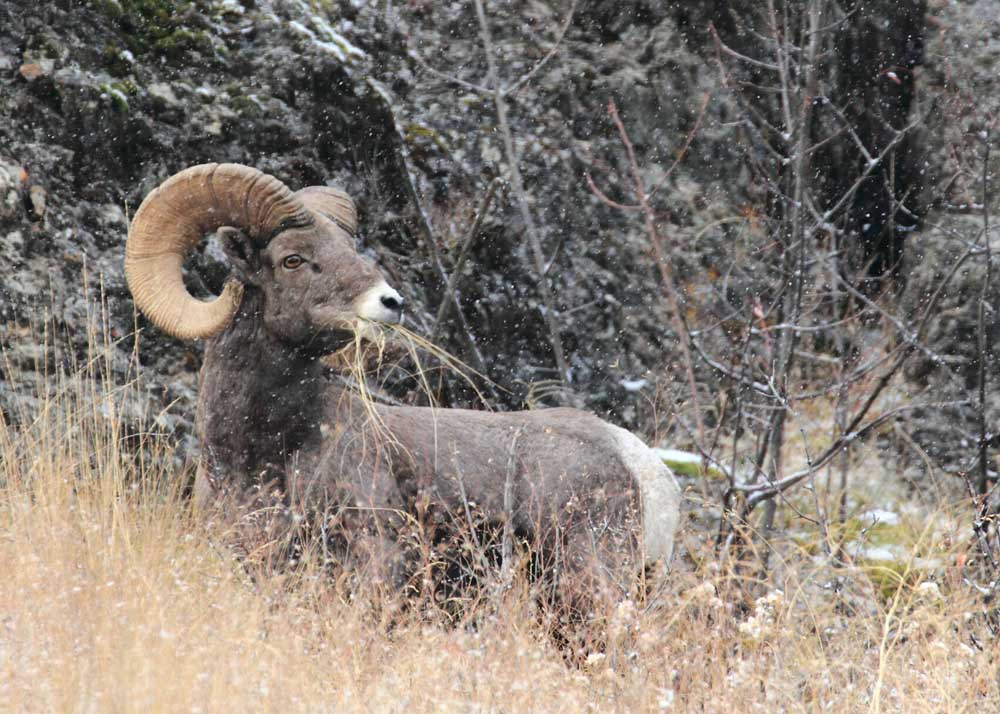Bacteria still threatens Baker County’s two bighorn sheep herds
Published 6:00 am Saturday, August 31, 2024

- A bighorn sheep ram in the Burnt River Canyon of southern Baker County in 2011.
BAKER CITY — A bacterial infection that started killing bighorn sheep in Baker County about five years ago still is circulating, but the latest evidence suggests the outbreak could be waning.
The long-term survival of the county’s two herds remains in jeopardy, however, because the illness continues to plague lambs, said Brian Ratliff, district wildlife biologist at the Oregon Department of Fish and Wildlife’s Baker City office.
Ratliff has been investigating the situation, along with other biologists, since lab tests in early 2020, from samples of dead bighorns in the Lookout Mountain Unit near Brownlee Reservoir between Richland and Huntington, confirmed the sheep were infected with a strain of Mycoplasma ovipneumoniae bacteria not previously found in Oregon bighorns.
Later in 2020, biologists confirmed the bacteria in bighorns in the Burnt River Canyon southwest of Durkee. The two herds, separated by Interstate 84, sometimes mingle.
The bacteria can cause fatal pneumonia.
Ratliff said although bighorn sheep are known for their ability to roam difficult terrain with ease, the sheep are quite vulnerable to a variety of viruses and bacteria that can quickly spread through nose-to-nose contact.
Sheep in the Burnt River Canyon began dying around October 2020, and Ratliff said he believes sheep from that herd crossed I-84 earlier in the year, mingled with infected Lookout Mountain bighorns and became ill, then returned and began spreading the bacteria among Burnt River Canyon sheep.
The source of the bacteria remains unknown, and almost certainly never will be determined conclusively, Ratliff said.
Bighorns can contract a variety of bacteria and viruses from domestic livestock, including sheep, but there is no evidence the bacteria arrived through domestic animals.
Sheep from two domestic flocks near Richland, at the north end of the Lookout Mountain Unit, were tested in 2020 and none was carrying the Mycoplasma ovipneumoniae bacteria, Ratliff said. A llama owned by a resident along the Snake River Road also was tested and was negative for the bacteria.
Ratliff said it’s possible a single bighorn that migrated into the area from Idaho or another state introduced the bacteria to the Baker County herds.
Two subspecies of bighorns
The Lookout Mountain sheep are Rocky Mountain bighorns. Prior to the disease outbreak, the herd numbered about 400 animals and was the biggest group of Rocky Mountain bighorns in Oregon.
Ratliff said the estimated population in the Lookout Mountain herd has been relatively steady at around 280 sheep the past couple of years.
Although bighorns are native to Oregon, they were largely extirpated due to overhunting in the late 19th and early 20th centuries.
ODFW established the Lookout Mountain herd in the early 1990s when a few dozen bighorns were captured elsewhere and released along Fox Creek. The animals have thrived in the steep canyons on the breaks of the Snake River.
Sheep in the Burnt River Canyon are California bighorns, a different subspecies that are somewhat smaller than Rocky Mountain bighorns.
The herd is much smaller, too, typically running around 80 to 90 sheep prior to the disease.
ODFW reintroduced California bighorns to the Burnt River Canyon in 1987.
Ratliff said there are around 40 sheep in the canyon now.
The overall situation is similar in both herds, Ratliff said.
The bacteria has killed relatively few adult sheep the past few years, he said.
The initial wave of sickness in 2020, by contrast, killed an estimated 75 adult bighorns in the Lookout Mountain herd.
But the bacteria is present in both herds, Ratliff said.
Biologists know that because the sheep they continue to capture, including eight from the Lookout Mountain herd in mid-June, have an antibody in their blood showing they have been exposed to the bacteria.
However, Ratliff said the antibody level in those sheep is much lower than it was a few years ago. That suggests the animals were not recently exposed to the bacteria, he said.
Ratliff said biologists believe a relatively small number of bighorns — perhaps just a few animals — are the source of the bacteria.
These are “shedders” — sheep that, though they aren’t sick, are shedding the bacteria, either constantly or intermittently.
Because few adult sheep, ewes and rams, have died the past few years, it’s likely those animals, due to their past exposure and the resulting antibodies, do not get sick even when they’re exposed to a shedding sheep, Ratliff said.
Biologists during surveys this year have found adults of both sexes look healthy, he said. And the large number of lambs born this spring in both herds shows ewes of breeding age are healthy enough to carry lambs to term.
But the herds remain in peril, Ratliff said.
The reason is lambs.
Lamb survival and the herds’ long-term prospects
Bighorn ewes don’t pass on protection from the bacteria to their lambs. The babies, then, are vulnerable to the infection.
In 2020 and 2021, there was no evidence any lambs born those years survived to their first birthday in either herd, Ratliff said.
Biologists did find many dead lambs both years.
An estimated five lambs survived in the Lookout Mountain herd in 2022, and about a dozen from the 2023 crop.
Prior to the bacteria outbreak, the herd typically produced about 70 surviving lambs per year, Ratliff said.
The survival rates from 2022 and 2023 are far too low to sustain either herd in the long term, he said.
Ewes as old as 16 or so can sometimes bear a lamb, but their chances of giving birth decline once they reach age 10 or so, Ratliff said.
Lambs are at risk in two main ways.
First, like babies of most species, they aren’t as hardy as adults.
Second, the social structure of bighorn herds exposes lambs to bacteria and viruses even when, as Ratliff suspects is the case with both Baker County herds, there are just a handful of sheep shedding the bacteria.
During summer the bighorns divide into “nursery groups,” with a few ewes watching over a dozen or more lambs, Ratliff said.
If one of the shedding sheep has contact with one of those nursery groups, it’s all but certain that every sheep, adult and baby, will be exposed.
That no longer puts the ewes at risk, given their high survival rates the past few years.
But exposure to the bacteria has proved a death sentence for a large majority of lambs. Ratliff said biologists hoped nursing lambs would receive some protection from the bacteria through antibodies in the milk, but that doesn’t seem to be the case.
Ratliff said the evidence points strongly to most, if not all, of the shedders being ewes rather than rams.
The reason, he said, is that rams spend most of the year in groups with other rams. They don’t mingle with the nursery groups, or with ewes except during the breeding season in the late fall.
If rams were the main sources of bacteria, then lamb survival should be higher because lambs have little if any contact with rams, Ratliff said.
The continuing low lamb survival rates suggest that at least some of the chronic shedders are ewes, which have contact with many lambs and thus expose them to the bacteria.
Ratliff said biologists continue to try to find those chronic shedders, which can be identified because swabs from their noses will reveal the virus. Sheep that aren’t shedders but have been exposed will have the antibody in their blood, but their nasal swabs will be free of the bacteria.
ODFW has killed one chronic shedder from the Lookout Mountain unit and six from the Burnt River Canyon herd, in 2022 and 2023.
Ratliff said the two herds are among the most closely studied in Oregon, largely because ODFW has captured 223 sheep from the Lookout Mountain herd over the past four years, fitting tracking collars to most of those animals, along with 65 sheep in the Burnt River Canyon.
Ratliff said both herds produced large numbers of lambs this spring. Biologists have found a few dead lambs in the Lookout Mountain Unit this summer, but they won’t know until an aerial survey this winter how many lambs have survived.
“It’s always a good sign when you see a lot of lambs around in the spring,” he said.
“It’s always a
good sign when you see
a lot of lambs around in the spring.”
— Brian Ratliff, biologist, Oregon Department
of Fish and Wildlife








